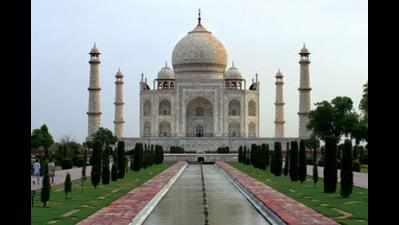Trending
This story is from September 29, 2016
UP tourism’s project to spruce up Taj surroundings gets historical dates wrong
UP tourism’s project to spruce up Taj surroundings gets historical dates wrong
UP chief minister’s ambitious venture, Tajganj project, meant to spruce up the surroundings of the iconic Taj Mahal, has ended up spreading a lot of incorrect history of the monument.

Agra: UP chief minister’s ambitious venture, Tajganj project, meant to spruce up the surroundings of the iconic Taj Mahal, has ended up spreading a lot of incorrect history of the monument. Wrong dates and information related to the Taj’s construction have been inscribed on several red sandstone tablets installed around the area to give information about the monument.The tourism department has sought an explanation from the private architecture and contractors in the matter.
One of such tablet installed near the monument’s east gate reads: “Created in 1609, the calligraphy at Taj has 22 different Quaranic Surahs or verses inscribed on the tomb.” The Taj Mahal was built between 1631 and 1648 and more interestingly, the reign of Shah Jahan, the Mughal emperor, who got the architectural marvel built in the memory of his favourite wife, Mumtaz Mahal, had started only in 1628. Moreover, Surah is a chapter, while Aayat means a verse in Quran and both have been interchanged casually at various places.
At another place, while describing the “inlay beauty” of the Taj, the tablet reads that the magnificent “Pietra Dura” inlay, with 28 kinds of semi-precious stones from around the world, enhance the beauty of Taj. However, according to ‘Taj Mahal and Its Conservation’, written by former superintending archaeologist of Archaeological Survey of India, as many 49 types of semi-precious stones were used in the inlay work of the Taj .
Sources in the UP tourism department revealed that the private architecture firm, installing these sandstone tablets, has not got the text being inscribed verified from any officials here.
“Since the matter has come to light, we have asked the persons concerned to send us the text. We will verify it and make sure that only right information is displayed,” they added.
When contacted, UP tourism’s deputy director (Agra) Dinesh Kumar said, “I will look into the matter and get the tablets replaced.”
Built at a cost of Rs 197 crore, Tajganj project is one of the most ambitious project of CM Akhilesh Yadav. Under the project, 15 slums and areas surrounding the Taj Mahal have been spruced up, while the roads in 500-meter radius of the monument will be built in red sandstones rather than bitumen.
A senior ASI official said, “Great care should be taken while dealing with the history. The issue becomes all the more sensitive when it is related to the Taj, as lakhs of tourists visit the monument every year. Any such mistake will spread misinformation and tarnish the image of the country.”
End of Article
FOLLOW US ON SOCIAL MEDIA










